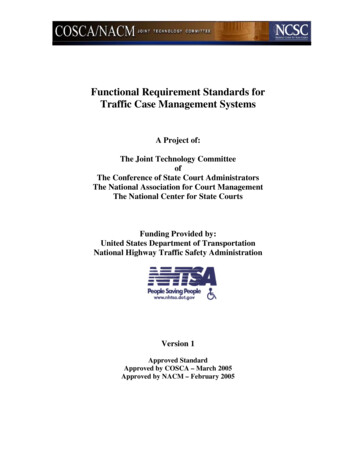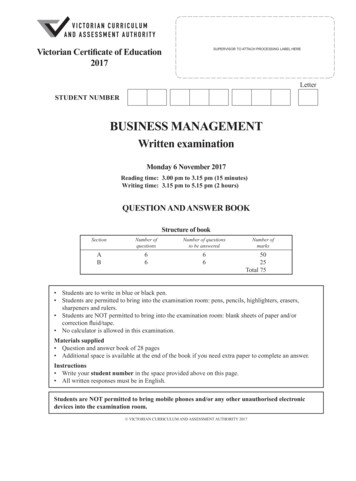
Transcription
Open Journal of Modern Linguistics, 2014, 4, 252-259Published Online June 2014 in SciRes. /10.4236/ojml.2014.42020A Case Study of Non-English Major CollegeStudents’ Motivation in English LanguageLearningMeilan JinCollege of Foreign Languages, Yanbian University, Yanji City, ChinaEmail: kml-0322@163.comReceived 27 February 2014; revised 2 April 2014; accepted 9 April 2014Copyright 2014 by author and Scientific Research Publishing Inc.This work is licensed under the Creative Commons Attribution International License (CC tractMotivation is considered as a key feature in the success of language learning and has great effecton the efficiency and productivity of English language teaching. And a lot of considerable researches and investigations have been done on Chinese college students’ motivation to learn English.Most researches like to value instrumental aspects as the major type for college students’ learningEnglish in Chinese context while integrative motivation is often neglected. In this study, 300 college students are employed to further explore students’ instrumental motivation and integrativemotivation and the data analysis of the study somehow shows difference from others, supportingthat college students do have expectation and strong integrative motivation toward English language learning and recommendations are offered to the teachers to develop college students’ integrative motivation in English language teaching, suggesting focusing on cultural education inparticular.KeywordsCase Study, College English Learning and Teaching, Instrumental Motivation, IntegrativeMotivation, Cultural Education1. IntroductionLearning and mastering a foreign language becomes a basic requirement for the citizens in the 21st century andChinese College English Curriculum Requirements (CCECR) stresses that College English is not only a language course that provides basic knowledge about English, but also a capacity enhancement course that helpsstudents broaden their horizons and learn about different cultures in the world, which clearly indicates that colHow to cite this paper: Jin, M. L. (2014). A Case Study of Non-English Major College Students’ Motivation in English Language Learning. Open Journal of Modern Linguistics, 4, 252-259. http://dx.doi.org/10.4236/ojml.2014.42020
M. L. Jinlege English teaching should be aimed at cultivating their intercultural communicative competence as well asdeveloping students’ English proficiency. However, it seems that college English teaching efficiency and productivity does not correspond with CCECR. Even though most of the college students learn English as a compulsory course, many of them show low motivation in English study and even completely give up learning Englishespecially after passing College English test-band 4 (CET-4), which made me have to rethink English teachingorientation and the motivation of both students’ English language learning (ELL) and teachers’ English languageteaching (ELT), in particular.Wang Chuming (1989) acknowledged that motivation was considered as one of the significant factors impacting foreign language learning. For Chinese students, instrumental motivation is the main type in Englishforeign language learning. The studies of Hua Huifang (1998) point out that almost 80% students’ motivation iscertificate motivation, and it is concluded in some studies (Hua, 2000; Shi, 2000) that integrative motivation isnot very important for English learning in Chinese context and “certificate motivation” is the major type, whichinfers that certificate motivation considered as a kind of instrumental motivation is more significant than integrative motivation for Chinese English learners. And there is a growing consensus that instrumental motivationor orientation perhaps should have a greater prominence in foreign language environment (Li, 2007; Xiang,2010) and that only a few of non-English majors just have the integrative motivation in ELL and most Chineselearners are not learning English for international communication but for social and economic mobility. As isshown, it’s pervasively believed that the instrumental orientation is the major Chinese learners’ ELL motivationand that it should be, which might have been misleading college students’ ELL and teachers’ ELT orientation.Brown (2000) maintains that both integrative motivation and instrumental motivation are not necessarily mutually exclusive. Based on the motivation theory, the study intends to further explore current college non-Englishmajor students’ instrumental and integrative motivation in ELL and support that college students do have expectation and integrative motivation toward ELL and concludes that it is a matter of great urgency to cultivate students’ integrative motivation in foreign language learning (FLL) in order to develop their intercultural communicative capacity and keep their long-term learning sustainable.2. Review of the Definition of MotivationAmid the last decade, with increasing attention paid to the roles of the learners in the process of language learning, there is a general consensus in the literature that motivation is one of the key learner characteristics. Manyteachers and researchers have done a lot of researches on the role of motivation and explored it from diverseperspectives such as behaviorism, cognitive psychology and sociology, which are all related and add to our understanding of what motivates students. Brown (1980) has made a statement that motivation is possibly the mostoften used catch-all term in explaining the success or failure of almost any complicated tasks. Deci and Ryan(1985) in their self-determination theory argue that different subtypes of motivation, i.e., intrinsic and extrinsicmotivation, can be shown along a continuum depending on the degree of self-determination. Crooks and Schmidt (1991) think it as the learner’s orientation regarding the goal of learning a second language and suggest thatmotivation to learn a language has both internal and external factors. Dörnyei (2009) maintains that motivationis one of the most important concepts in psychology and language education, which is commonly used to explain learners’ success and failure in learning.However, it is the work of Gardner and his associates that has heavily influenced the research on motivationin SLA. Gardner (1972) has suggested that motivation is considered as a central element along with languageproficiency in determining the success in the process of learning other language. He suggests that motivation isinfluenced by two orientations to language learning which are integrative orientation and instrumental orientation. Gardner et al. (1977) define them as follows: Integrative reasons are defined as those that indicate an interest in learning the language in order to meet and communicate with members of the second language community.Instrumental reasons refer to those reasons, which stress the pragmatic aspects of learning the second language,without any particular interest in communicating with the second language community.With instrumental motivation, the purpose of language acquisition is more practical, such as meeting a requirement for school or college graduation, seeking for a job, reading technical and scientific materials, doingtranslation works, doing some traveling etc. While both integrative and instrumental reasons are essential elements of success, it is integrative motivation that has been found to sustain long-term success sustainable whenlearning a second language (Taylor, 1977; Ellis, 1997; Crookes, 1991). It is thought that students who are most253
M. L. Jinsuccessful when learning a target language are those who like the people that speak the language, admire theculture and have a desire to become familiar with or even integrate into the society in which the language is used(Falk, 1978).As is shown, various definitions of motivation have been suggested over the decades and since researchersdefine motivation from different perspectives, it has been classified into various kinds: such as internal and external, integrative and instrumental, intrinsic and extrinsic, etc. The present study mainly focuses on “instrumental orientation” and “integrative orientation” and highlights the latter.3. Research Method3.1. ParticipantsThe participants are 300 freshmen from 8 classes of 2012, YBU. In order to make the questionnaire more reliable and accurate, the study employs the participants from different level classes-4 lower intermediate classes(Group A, N-142) and 4 high-level classes (Group B, N-158), which were divided after the students were assessed at the beginning of the 1st semester in 2012. At the time of data collection, most of them had been learning English as a foreign language in China at least for 10 years, while they have uneven and various personalities, goals and levels of motivation. The respective percentage of passing CET-4 for each group after studentsfirst participated in the CET-4 exam in December, 2012 is 4.2% for Group A (only 4 students passed CET-4) and65.8% for Group B (104 students did). Therefore, the subjects selected from both lower intermediate classes andhigh-level classes for investigation are quite representative to assure the reliability and accuracy of the study.3.2. Design and ProceduresThe main purpose of the investigation is to find whether and how motivation factors, especially integrative factors are connected with non-English major college students’ ELL. Two data collection instruments were used inthe study: questionnaire for students and CET-4 grades reported by students themselves. The essential questionnaire, which consists of 10 typical items, relevant to instrumental and integrative motivation in EFL, was designed on the basis of previous motivation theory and what we have to discuss. The students were required toread each item and choose the most situation applied to them. Among 6 reactions attached to each item withstrongly agree (SA), agree (A), possibly agree (PA), possibly disagree (PD), disagree (D), and strongly disagree(SD), only first two reactions, SA and A were adopted to analyze students’ positive motivation. The questionnaire was finished over two weeks in June, 2013 and the data was calculated with the assistance of MicrosoftExcel.4. Results and Discussion4.1. Percentage of Instrumental OrientationAs Table 1 shows, among the five items of instrumental orientation, first two items, “to travel around or getmore information about the world” (72%), and “to get a satisfying job” (68.6%) are the most important reasonsfor college students to learn English and nearly 50.4% of the students show instrumental intensity in the item “togo abroad for academic study”, and the percentage of “to operate computers conveniently” is 46.7%. All of thiscan imply that students have clear instrumental motivation of ELL. In particular the percentage of 68.6% for “toget a satisfying job” is pretty reasonable for the college students who feel under stress of career choices. However, ironically, there is exception with the lowest percentage of “to pass exams like CET-4” reaching only24.3%. In view of regarding “certificate motivation” as one of the major factors for Chinese college students tolearn English, it cannot be a bigger reverse.4.2. Percentage of Integrative OrientationThe items from 8 to 12 in Table 2 are mainly designed to investigate students’ integrative orientation. As isshown in Table 2, to the item “To watch movies or read works in English”, “To talk with various of people byusing English”, “To communicate freely with English native speakers”, “To better understand the society andculture in English speaking countries” and “To get satisfaction due to English proficiency”, SA and A percentage254
M. L. JinTable 1. Percentage of instrumental orientation (N-300).ItemsSAAPAPDDSD1) To travel around or get more information about the world38.0% 11434% 10220% 604.% 122% 62% 62) To find a satisfying job26.3% 7942.3% 12720.7% 624.3% 133.8% 112.7% 83) To go abroad for academic study22.7% 6827.7% 8323.7% 7112.3% 3710.7% 323% 94) To operate computers conveniently13.7% 4133% 9923.7% 7113.7% 4112.7% 383.3% 106% 1818.3% 5520.7% 6218.7% 5617.3% 5219% 57SAAPAPDDSD6) To watch movies or read works in English39.7% 11930.7% 9217.7% 538.7% 262.7% 81% 37) To talk with various of people by using English32.7% 9836% 10819.4% 585.7% 173% 93.3% 108) To communicate freely with English native speakers36% 10830.3% 9118.5% 5410.3% 312% 64.3% 139) To better understand the society and culturein English speaking countries33.7% 10132% 9620.4% 6110.7% 322% 64.3% 1310) To get satisfaction due to English proficiency31.3% 9432% 9618.3% 5512.% 364.3% 132% 65) To pass the exams (CET-4/CET6 etc.)Table 2. Percentage of integrative orientation (N-300).Itemsis 70.4%, 68.7%, 66.3%, 65.7% and 63.3% respectively and its average value is 14.5% higher than that of instrumental orientation (52.4%), which suggests that students seem to have stronger integrative orientation inELL, different from prior studies considering that only a few students have integrative motivation in ELL.4.3. Percentage of Comparison of Instrumental Orientation of Group A and Group BIn order to get precise data to support the study, comparison of students’ motivation between GA and GB tolearn English is conducted. As is shown in Table 3, percentage of “To go abroad for academic study “is 50% forGA and 51% for GB”, and “To operate computers conveniently” is 48% for GA and 46% for GB, which appearsless mean difference. However, the percentage of “pass the exams like CET-Band 4” is 33% for GA and 17% forGB, “To find a satisfying job” is 72% for GA and 66% for GB, and “To travel around or get more informationabout the whole world” is 67% for GA and 77% for GB respectively, implying that low achievers from GA havemore powerful instrumental orientation under stress to pass the exams to get the certificate or to get a better job.4.4. Percentage of Comparison of Integrative Orientation of Group A and Group BSA and A percentage of comparison of “To watch movies or read works in English”, “To talk with various ofpeople by using English”, “To communicate freely with English native speakers”, “To better understand the society and culture in English speaking countries” and “To get satisfaction due to English proficiency”, shows obvious mean difference with GB holding higher percentage in every item, which is 15%, 18%, 15%, 24% and 23%higher respectively. Undoubtedly, Table 4 supports the conclusion made by previous researches that integrativemotivation correlates positively with motivational intensity and interest in English and the students with integrative motivation show much more interest in the culture, the people and other aspects of the target language andmore successful in learning target language than those who are instrumentally motivated. However, with averagevalue of 56.8%, students from GA also show a little higher integrative orientation than instrumental orientationwhose average value is 54% in accordance with the data result.As a whole, the thought that for most of the college non-English majors, they study English because of instrumental motivation or certificate motivation is somewhat subjective and incomplete without considering students’ implicit necessity―students’ inner, intrinsic, and integrative factors. It’s true that a large number of students learn English to pursue their own goals, such as getting good grades in the exams, passing the CET-4, andgetting good jobs after graduation; it’s true that most students have no more interest in ELL and even give up255
M. L. JinTable 3. Comparison of instrumental orientation of Group A (N-142) and Group B (N-158).Items1) To travel around or get more information about the whole world2) To find a satisfying job3) To go abroad for academic study4) To operate computers conveniently5) To pass the exams (CET-4/ CET6 etc.)GroupSAAGA (142)37% (52)30% (43)GB (158)39% (62)38%(59)GA (142)31% (44)41% (58)GB (158)22% (35)44% (69)GA (142)21% (30)29% (41)GB (158)24% (38)27% (42)GA (142)15% (21)33% (47)GB (158)13% (20)33% (52)GA (142)11% (15)22% (31)GB (158)2% (3)15% (24)Table 4. Comparison of integrative orientation of Group A (N-142) and Group B (N-158).Items6) To watch movies or read works in English7) To talk with various of people by using English8) To communicate freely with English native speakers9) To better understand the society and culture in English speaking countries10) To get satisfaction due to English proficiencyGroupSAAGA (142)33% (47)30% (42)GB (158)46% (72)32% (50)GA (142)31% (44)28% (40)GB (158)34% (54)43% (68)GA (142)28% (40)30% (43)GB (158)43% (68)30% (48)GA (142)26% (37)27% (39)GB (158)41% (64)36% (57)GA (142)26% (37)25% (36)GB (158)36% (57)38% (60)learning English as long as they pass CET-4; it’s true that most learners really have few opportunities to communicate directly with English native speakers in Chinese context. However, it is subjective and unreasonable toconclude they don’t have much interest in the culture, the people, and other aspects of the target language. Asthe survey reveals, many more students do express interest in learning English, wish to meet and communicatewith members of the English language community, and they are passionate about target language culture, whichimply their motivation to learn English does not only arise for instrumental orientation. Apart from the results ofthe motivation questionnaire, observing the students through the classroom teaching in which more cultural factors are involved also shows that they are really interested in the target language culture. There is no doubt thatstudents are primarily motivated by instrumental factors in Chinese context but we have to realize that it is because of certain social and educational backgrounds in China.In the process of the survey, the doubt emerged that motivation of learning English like “to travel around orget more information about the world” is somewhat different from such instrumental factors as entering a college, passing the exam, or getting a better job, and so on, even though previous researchers identified it as instrumental motivation and so it is. Cognitive approaches suggest that students can be motivated to perform well,not only because of rewards such as grades or praise, but because of factors such as interest, curiosity, the needto obtain information or solve a problem, or the desire to understand (Kenneth, 2005) Therefore, it may be betterto treat the high intensity of “to travel around or get more information about the whole world” as the demonstra-256
M. L. Jintion of students’ intrinsic interest in ELL, as Noels et al. (2000) put it, the activity is enjoyable and satisfying todo. In addition, for most people, except for the relaxation from routines and the feast for the eyes, one of thepurposes to travel or get more information about the world may be to broaden their horizons, enrich their experiences and get perception of life, especially by touching local customs and habits, which suggests they wouldlike to become familiar with or even integrate into the different cultures and society. Thus, it may be feasible toperceive such motivation to learn English as “to travel around or get more information about the world” as integrative orientation. Broadly speaking, the data results support that Chinese college and university students havepowerful integrative orientation in center.5. Conclusion and Recommendation5.1. ConclusionGlobal age or world is the hot concept of educational world. We have to realize that with the development of social economy, living in an age of global information, college and university students have been broadening theiroutlook and expecting to know and learn things outside of their special and limited areas, and this kind of trendof motivation is meaningful to guide ELT. Based on the survey, I’d like to draw conclusions as follows:Most students are aware of the important role of English in both life and academic filed, and have clear andstrong instrumental and integrative motivation in learning English.In accordance with the survey, students, regardless of learning in high level classes or lower intermediateclasses, display strong integrative intensity in ELL, which is not lying around on the ground but needs discovering, excavating and cultivating.The prior conclusion that instrumental motivation is Chinese college students’ major orientation to learn English sounds somewhat subjective and unreasonable, lack of insight to understand the complex situations wherestudents have to. The situation where students’ are primarily motivated by instrumental factors is not caused bystudents’ will but is partially imposed on the students in certain social and educational backgrounds in China.What’s more, instrumental motivation like “to learn English is to travel around or get more information aboutthe world” more or less displays integrative orientation.For the students, the lower their grades are, the stronger their instrumental orientation is under stress to passthe exams to get the certificate or to get a better job, but it has less to do with students’ holding integrativeorientation.There are still approximately 30% of the students lack of the real awareness of English learning who need tobe guided. And even though more than half of the students show integrative orientation in ELL, it doesn’t meanthey make full use of it in ELL as is discussed in previous studies.With only 10 items utilized in the questionnaire and only 300 students from Yanbian University employed tocomplete the questionnaire, the present study may not fully represent all Chinese non-English majors. Despitethis limitation, the results of the study support that we should acknowledge students’ integrative motivation andvalue the motivation toward ELL and cultivate it. In addition, the fact that cannot be missed is that there is avery big gap between the development of English Education of metropolitan cities and that of Yanji City whereYanbian University is located, without even decent remedial or additional English class for TOEFL or IELTS. Inother words, since students from YBU have such strong integrative motivation to learn English, let alone thosestudying in colleges or universities in other areas under the influence of globalization of the English language.All these findings cannot be more important and meaningful to guide ELT.As a whole, both instrumental motivation and integrative motivation are nothing less in Chinese context.However, focusing only on what is most easily measured or on immediate practical impact is to miss the deeperpoint. The point is how to support students’ integrative motivation and let it come into play, leading to developing students’ intercultural communicative competence and their long-term learning being sustainable where thelearners are supplied with no chances to make most of target language and no opportunities to keep interactionswith members of the target language.5.2. RecommendationIn the light of globalization of the English language, the success of ELT does not only depend on improvingstudents’ knowledge and skills of English language but also developing their cultural capacity and intercultural257
M. L. Jincommunicative competence, which implies that cultivating students’ integrative motivation is a matter of greaturgency in foreign language teaching. To promote genuine cultural awareness and international understandingand to ensure the efficiency and productivity of college English teaching, teachers are supposed to keep themselves abreast of new research and knowledge in the teaching of language acquisition and be prepared with sufficient cultural knowledge of the target language. The below are the recommendations offered to the teachers todevelop students’ integrative motivation in ELT.Firstly, teachers should raise their own awareness of the relationship of culture and language and try to improve their awareness of culture teaching, which is to absolutely affect students’ integrative motivation orientation. Secondly, teachers should continue to improve students’ awareness of learning English and let students understand English learning is a life style rather than simply being a preparation for passing examination. Thirdly,teachers should enhance students’ learning autonomy, not only in classroom but also after class by designing andassigning lots of available tasks so that students have a number of opportunities to use English, for the more theyuse English in their everyday lives, the more quickly their acquisition and proficiency improve and so do in return their confidence and autonomy in ELL. Fourthly, teachers should create a strong classroom communitywhere students use the target language to learn, touch and share the culture, by designing and/or selecting teaching materials that are international and inclusive in scope, which is available enough for the teachers to obtainwith the development of modern science and technology.In a word, there should be changes in teaching philosophy. Without changes in teaching philosophy and a shiftfrom instrument-centered pattern, in which knowledge of the language and skills are imparted by the teacher inclass, to the integration-centered pattern, in which both language teaching and culture teaching are connectedwith each other, our students would ever have to remain as instrument-oriented learners, which means it wouldbe unachievable to develop students’ intercultural communicative competence and to keep their long-termlearning being sustainable.ReferencesBrown, H. D. (1980). The Optional Model of SLA. TESOL Quarterly, 14, 64-157.Brown, H. D. (2000). Principles of Language Learning and Teaching (4th ed.). New York: Prentice Hall.Crookes, G., & Schmidt, R. W. (1991). Motivation: Reopening the Research Agenda. Language Learning, 41, .tb00690.xDeci, E. L., & Ryan, R. M. (1985). Intrinsic Motivation and Self Determination in Human Behaviour. New York: PlenumPress. i, Z. (2009). The L2 Motivational Self System. In Z. Dornyei, & E. Ushioda (Eds.) Motivation, Language Identityand the L2 Self, Clevedon: Multilingual Matters.Ellis, R. (1997). The Study of Second Language Acquisition. Oxford: Oxford University Press.Falk, J. (1978). Linguistics and Language: A Survey of Basic Concepts and Implications (2nd ed.). New York: John Wileyand Sons.Gardner, R. C., & Lambert, W. E. (1972). Attitudes and Motivation in Second Language Learning. Rowley, MA: NewburyHouse Publishers.Gardner, S., & Brunet, G. R. (1977). Intensive Second Language Study: Effects on Attitudes, Motivation and FrenchAchievement. Language Learning, 27, 243-261. .xHenson, K. T., & Eller, B. F. (2005). Educational Psychology for Effective Teaching. Beijing: Foreign Language Teachingand Research Press.Hua, H. F. (1998). Discussion on the Study of the Motivation and Strategies of Learning English. Journal of the ForeignLanguage World, 3.Hua, H. F. (2000). A Study on the Motivation and Strategies of Learning English. Journal of the Foreign Language World, 3,44-47.Li, J. W. (2007). A Case Study of Changing Motivation in Foreign Language Learning. Teaching English China, 3, 61.Noels, K. A., Pelletier, L. G., Clement, R., & Vallerand, R. J. (2000). Why Are You Learning a Second Language? Motivational Orientations and Self-Determination Theory. Language Learning, 50, , Y. Z. (2000). A Survey of College Students’ Learning English. Foreign Language Teaching, 4, 8-11.258
M. L. JinTaylor, D. M., Meynard, R., & Rheault, E. (1977). Threat to Ethnic Identity and Second-Language Learning. In H. Giles(Ed.), Language, Ethnicity and Intergroup Relations (pp. 99-118). London and New York: Academic Press.Wang, C. M. (1989). Chinese Students’ Learning Patterns of Foreign Languages. Foreign Language Teaching and Research,4.Xiang, H. B. (2010). Motivation Theories and Its Inspirations in College English Teaching. Master Dissertation, Qingdao:Qingdao University of Science and Technology.259
ing English as a foreign language in China at least for 10 years, while they have uneven and various personali- ties, goals and levels of motivation. The respective percentage of passing CET-4 for each group after students first participated in the CET-4 exam in December, 2012 is 4.2% for Group A (only 4 students passed CET-4) and 65.8% for Group B (104 students did). Therefore, the subjects .











